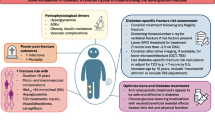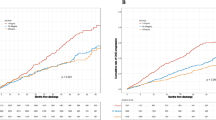Abstract
Summary
In this clinical trial of 12.5 or 25 mg/day of hydrochlorothiazide, the urine calcium showed significant decreases from placebo in men at one year, but the effects had waned by 3 years. Serum bicarbonate was consistently greater in the thiazide than in the placebo groups throughout the three years. These effects could be beneficial to the skeleton.
Introduction
Previous studies have shown increased bone density and reduced risk of fracture in patients taking thiazide diuretics. The long-term effects of low-dose thiazides on mineral metabolism have not been reported in normal subjects.
Methods
We conducted a randomized, double-blinded trial in normals aged 60–79 years, using hydrochlorothiazide 12.5 or 25 mg/d or placebo for three years. Subjects were encouraged to maintain calcium intake of 1,000 to 1,500 mg/day. Measurements of serum and urine calcium metabolism were done at baseline, six months, and yearly. Data were analyzed in 88 men and 177 women who had taken study medication. Adjusted change in the measurements from baseline to one and three years were compared among groups.
Results
The calcium intake increased in all groups. Urine calcium per day was significantly lower in thiazide than placebo groups in men at one year but not at three years; in women the changes were not significantly different. Serum bicarbonate was higher in thiazide compared to placebo groups at one and three years. No changes were seen in serum calcium, phosphate, parathyroid hormone, sodium or magnesium.
Conclusions
The results suggest that both increased calcium availability from a hypocalciuric effect and reduction in acid-induced bone buffering could be mechanisms for the beneficial skeletal effects.



Similar content being viewed by others
References
LaCroix AZ, Wienpahl J, White LR, Wallace RB, Scherr PA, George LK, Cornoni-Huntley J, Ostfeld AM (1990) Thiazide diuretic agents and the incidence of hip fracture. N Engl J Med 322:286–290
Jones G, Nguyen T, Sambrook PN, Eisman JA (1995) Thiazide diuretics and fractures: can meta-analysis help? J Bone Miner Res 10:106–111
Feskanich D, Willett WC, Stampfer MJ, Colditz GA (1997) A prospective study of thiazide use and fractures in women. Osteoporos Int 7:79–84
Schlienger RG, Kraenzlin ME, Jick SS, Meier CR (2004) Use of beta-blockers and risk of fractures. Jama 292:1326–1332
Rejnmark L, Vestergaard P, Mosekilde L (2005) Reduced fracture risk in users of thiazide diuretics. Calcif Tissue Int 76:167–175
Wiens M, Etminan M, Gill SS, Takkouche B (2006) Effects of antihypertensive drug treatments on fracture outcomes: a meta-analysis of observational studies. J Intern Med 260:350–362
Bauer DC, Browner WS, Cauley JA, Orwoll ES, Scott JC, Black DM, Tao JL, Cummings SR (1993) Factors associated with appendicular bone mass in older women. The Study of Osteoporotic Fractures Research Group. Ann Intern Med 118:657–665
Orwoll ES, Bevan L, Phipps KR (2000) Determinants of bone mineral density in older men. Osteoporos Int 11:815–821
Transbol I, Christensen MS, Jensen GF, Christiansen C, McNair P (1982) Thiazide for the postponement of postmenopausal bone loss. Metabolism 31:383–386
LaCroix AZ, Ott SM, Ichikawa L, Scholes D, Barlow WE (2000) Low-dose hydrochlorothiazide and preservation of bone mineral density in older adults. A randomized, double-blind, placebo-controlled trial. Ann Intern Med 133:516–526
Reid IR, Ames RW, Orr-Walker BJ, Clearwater JM, Horne AM, Evans MC, Murray MA, McNeil AR, Gamble GD (2000) Hydrochlorothiazide reduces loss of cortical bone in normal postmenopausal women: a randomized controlled trial. Am J Med 109:362–370
Wasnich RD, Davis JW, He YF, Petrovich H, Ross PD (1995) A randomized, double-masked, placebo-controlled trial of chlorthalidone and bone loss in elderly women. Osteoporos Int 5:247–251
Looker AC, Wahner HW, Dunn WL, Calvo MS, Harris TB, Heyse SP, Johnston CC Jr, Lindsay R (1998) Updated data on proximal femur bone mineral levels of US adults. Osteoporos Int 8:468–489
Kristal A, Feng Z, Coates R, Oberman A, George V (1997) Associations of race/ethnicity, education, and dietary intervention with the validity and reliability of a food frequency questionnaire: the Women's Health Trial Feasibility Study in Minority Populations. Am j Epidemiol 146:856–869
Preminger GM, Pak CY (1987) Eventual attenuation of hypocalciuric response to hydrochlorothiazide in absorptive hypercalciuria. J Urol 137:1104–1109
Odvina CV, Preminger GM, Lindberg JS, Moe OW, Pak CY (2003) Long-term combined treatment with thiazide and potassium citrate in nephrolithiasis does not lead to hypokalemia or hypochloremic metabolic alkalosis. Kidney Int 63:240–247
Greenberg A (2000) Diuretic complications. Am J Med Sci 319:10–24
Barry EL, Gesek FA, Kaplan MR, Hebert SC, Friedman PA (1997) Expression of the sodium-chloride cotransporter in osteoblast-like cells: effect of thiazide diuretics. Am J Physiol 272:C109–116
Lalande A, Roux C, Graulet AM, Schiavi P, De Vernejoul MC (1998) The diuretic indapamide increases bone mass and decreases bone resorption in spontaneously hypertensive rats supplemented with sodium. J Bone Miner Res 13:1444–1450
Nicolet-Barousse L, Blanchard A, Roux C, Pietri L, Bloch-Faure M, Kolta S, Chappard C, Geoffroy V, Morieux C, Jeunemaitre X, Shull GE, Meneton P, Paillard M, Houillier P, De Vernejoul MC (2005) Inactivation of the Na-Cl co-transporter (NCC) gene is associated with high BMD through both renal and bone mechanisms: analysis of patients with Gitelman syndrome and Ncc null mice. J Bone Miner Res 20:799–808
Mayan H, Vered I, Mouallem M, Tzadok-Witkon M, Pauzner R, Farfel Z (2002) Pseudohypoaldosteronism type II: marked sensitivity to thiazides, hypercalciuria, normomagnesemia, and low bone mineral density. J Clin Endocrinol Metab 87:3248–3254
Sutton RA (1985) Diuretics and calcium metabolism. Am J Kidney Dis 5:4–9
Bollard MJ, Ames RW, Horne AM, Orr-Walker BJ, Gamble GD, Reed IR (2007) The effect of treatment with a thiazide diuretic for 4 years on bone density in normal postmenopausal women. Osteoporos Int 18:479–486
Lemann J Jr, Bushinsky DA, Hamm LL (2003) Bone buffering of acid and base in humans. Am J Physiol Renal Physiol 285:F811–832
Bushinsky DA (2001) Acid-base imbalance and the skeleton. Eur J Nutr 40:238–244
Frassetto LA, Nash E, Morris RC, Sebastian A (2000) Comparative effects of potassium chloride and bicarbonate on thiazide-induced reduction in urinary calcium excretion. Kidney Int 58:748–752
Jehle S, Zanetti A, Muser J, Hulter HN, Krapf R (2006) Partial neutralization of the acidogenic Western diet with potassium citrate increases bone mass in postmenopausal women with osteopenia. J Am Soc Nephrol 17:3213–3222
Funding
National Institutes of Health (AG09825) and University of Washington Clinical Nutrition Research Unit, National Institutes of Health (P30 DK35816). The study medications were provided by Ciba-Geigy.
Conflicts of interest
None of the authors have any conflicts of interest.
Author information
Authors and Affiliations
Corresponding author
Rights and permissions
About this article
Cite this article
Ott, S.M., LaCroix, A.Z., Scholes, D. et al. Effects of three years of low-dose thiazides on mineral metabolism in healthy elderly persons. Osteoporos Int 19, 1315–1322 (2008). https://doi.org/10.1007/s00198-008-0612-4
Received:
Accepted:
Published:
Issue Date:
DOI: https://doi.org/10.1007/s00198-008-0612-4




